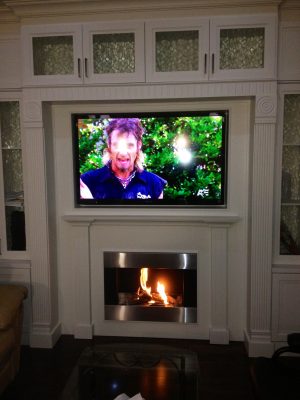Elegance and super-efficiency at standard custom costs
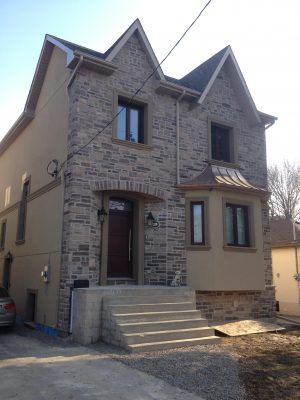 Reiner Hoyer is an award-winning Toronto contractor with 30 years experience, and he’s just completed his favourite project of all. Not surprisingly, it’s a house he built for himself and his wife Melanie, though this fact alone isn’t why Hoyer’s smiling these days. Energy performance and indoor air quality are the main reasons he’s so happy, and you can’t blame him. Hoyer’s house brings together enough leading edge construction technology that the structure requires no outside supplemental heat. Even when temps drop to -10ºC outdoors, the thermometer still reads a cozy +23ºC inside, thanks to nothing more than the incidental heat given off by high-efficiency lighting, small rooftop solar collectors, cooking and body heat. No furnace, baseboard heaters or gas fireplace necessary. Heiner’s house is gorgeous, too – no glass greenhouse look here. Indoor air quality is fresh and healthy, and anyone can build a house like this for 5% to 10% more than an ordinary custom home. All in all, it’s more than a good news story. Hoyer’s project proves how building a ultra-high efficiency, furnace-free home is possible in the real world using real trades and materials that anyone can get.
Reiner Hoyer is an award-winning Toronto contractor with 30 years experience, and he’s just completed his favourite project of all. Not surprisingly, it’s a house he built for himself and his wife Melanie, though this fact alone isn’t why Hoyer’s smiling these days. Energy performance and indoor air quality are the main reasons he’s so happy, and you can’t blame him. Hoyer’s house brings together enough leading edge construction technology that the structure requires no outside supplemental heat. Even when temps drop to -10ºC outdoors, the thermometer still reads a cozy +23ºC inside, thanks to nothing more than the incidental heat given off by high-efficiency lighting, small rooftop solar collectors, cooking and body heat. No furnace, baseboard heaters or gas fireplace necessary. Heiner’s house is gorgeous, too – no glass greenhouse look here. Indoor air quality is fresh and healthy, and anyone can build a house like this for 5% to 10% more than an ordinary custom home. All in all, it’s more than a good news story. Hoyer’s project proves how building a ultra-high efficiency, furnace-free home is possible in the real world using real trades and materials that anyone can get.
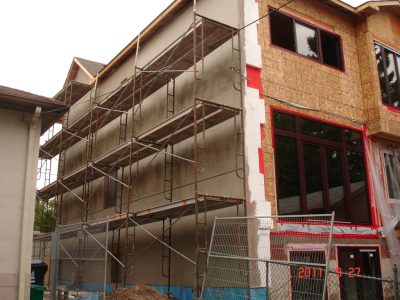 Hoyer’s project began with an energy guzzling 1950s Toronto bungalow. The basement and one exterior wall was saved to meet zoning requirements to allow a rental suite in the basement. The end result is an elegant, three storey home built following design parameters of the Passive House movement. (www.passivehouse.ca). Not to be confused with “passive solar” houses, Passive Houses use efficient building shape, solar exposure, superinsulation, advanced windows, leading-edge ventilation and subtle technical features that require little or no energy inputs from conventional heating or cooling systems. There are 25,000 Passive Houses in Europe right now, but the idea is new enough in Canada that Hoyer’s project was almost strangled by building department red tape before it ever got going. The inability of the building inspection department to efficiently recognize new-to-them construction technologies that are proven and used elsewhere was a bigger challenge than building a house that stays warm in Canadian winters without a furnace. To learn more about the bureaucratic challenges of Hoyer’s project, see “Old Dog Snarls at New Tricks” below.
Hoyer’s project began with an energy guzzling 1950s Toronto bungalow. The basement and one exterior wall was saved to meet zoning requirements to allow a rental suite in the basement. The end result is an elegant, three storey home built following design parameters of the Passive House movement. (www.passivehouse.ca). Not to be confused with “passive solar” houses, Passive Houses use efficient building shape, solar exposure, superinsulation, advanced windows, leading-edge ventilation and subtle technical features that require little or no energy inputs from conventional heating or cooling systems. There are 25,000 Passive Houses in Europe right now, but the idea is new enough in Canada that Hoyer’s project was almost strangled by building department red tape before it ever got going. The inability of the building inspection department to efficiently recognize new-to-them construction technologies that are proven and used elsewhere was a bigger challenge than building a house that stays warm in Canadian winters without a furnace. To learn more about the bureaucratic challenges of Hoyer’s project, see “Old Dog Snarls at New Tricks” below.
Super-Insulated, Super-Sealed
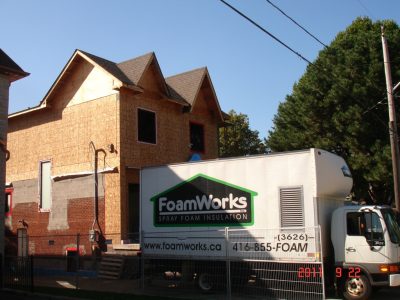 Retaining energy investments in heated and cooled air indoors is job#1 with any Passive House, and code-minimum levels of insulation will never do this job. That’s why Hoyer built exterior walls with roughly double the usual amount of insulation: R60 for south, east and west walls, R70 for north-facing walls and R90 in the attic. But R value alone isn’t the only issue when it comes to insulation. In fact, R values are not even the most important issue.
Retaining energy investments in heated and cooled air indoors is job#1 with any Passive House, and code-minimum levels of insulation will never do this job. That’s why Hoyer built exterior walls with roughly double the usual amount of insulation: R60 for south, east and west walls, R70 for north-facing walls and R90 in the attic. But R value alone isn’t the only issue when it comes to insulation. In fact, R values are not even the most important issue.
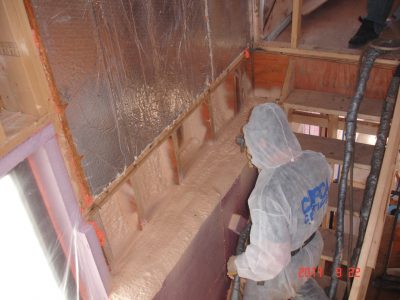 Almost all the insulation Hoyer used is some kind of foam – either spray or rigid sheets – and there’s a reason for it. Foam delivers consistent energy performance. It’s unaffected by drafts and air movement. By contrast, fiber-based batts are a different matter entirely. They may say R20 on the bag, but that number comes from measurements taken under ideal lab conditions in a sealed hot box. Real world batt insulation values are often drastically lower as air movement and drafts travel through wall frames. You can put all the building wrap and vapour barrier you want on a stud frame wall and air is still going to move through the insulation. You simply cannot build a Passive House without foam.
Almost all the insulation Hoyer used is some kind of foam – either spray or rigid sheets – and there’s a reason for it. Foam delivers consistent energy performance. It’s unaffected by drafts and air movement. By contrast, fiber-based batts are a different matter entirely. They may say R20 on the bag, but that number comes from measurements taken under ideal lab conditions in a sealed hot box. Real world batt insulation values are often drastically lower as air movement and drafts travel through wall frames. You can put all the building wrap and vapour barrier you want on a stud frame wall and air is still going to move through the insulation. You simply cannot build a Passive House without foam.
Perhaps the most unusual part of Hoyer’s house is the approach he took to insulating the basement. He used a full coverage design that put sheets of extruded polystyrene foam on walls, sealed under a layer of soya-based spray foam insulation. Spray foam is also continuous over the entire surface of the existing concrete floor of the old bungalow, with floor insulation values topping out at R60. Four inches of reinforced concrete was poured on top of this floor foam, encasing radiant infloor heating pipes. Metal stud walls sit on top of this concrete floor, located just inside the foam sprayed on exterior walls. The end result is complete thermal isolation from the earth, with a basement floor that acts as a massive thermal flywheel.
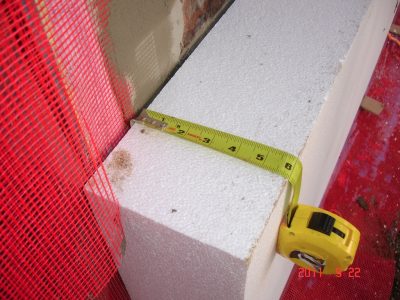 The outside three walls of the house are finished in synthetic stucco, and it’s applied over a whopping 6” of expanded polystyrene foam that’s anchored to a wall retained from the old house. Ray-Core SIPs were used to create new exterior walls elsewhere. The front of the house is finished with a stone veneer that’s applied over a 2”-thick layer of spray foam applied over the SIPs.
The outside three walls of the house are finished in synthetic stucco, and it’s applied over a whopping 6” of expanded polystyrene foam that’s anchored to a wall retained from the old house. Ray-Core SIPs were used to create new exterior walls elsewhere. The front of the house is finished with a stone veneer that’s applied over a 2”-thick layer of spray foam applied over the SIPs.
The attic is filled with 30” of blown-in cellulose insulation, amounting to a whopping R90 of heat retention. A laser level was used during installation to ensure even and complete attic insulation coverage.
Besides superior insulation performance, Hoyer’s heavy use of foam offers another big pay-off. Spray foam seals out drafts like nothing else can, and low air infiltration is key to meeting Passive House standards. Nothing more than 0.5 air changes per hour (ACH) is considered acceptable, and Hoyer’s house came in at an impressive 0.27 ACH, despite retention of an existing wall and basement from the old bungalow. That’s 11 times less air leakage than some of the highest new Canadian building code standards coming into effect right now.
Hoyer chose triple pane Geneo windows delivering R9.5 centre-of-pane insulation values. The frames are made from a proprietary blend of fiberglass and PVC that’s strong enough to function without need for metal reinforcement. It’s the same material used to make the bumpers of German cars, and even dark colours don’t expand and warp with the sun’s heat.
Vacuum Tube Solar Collectors
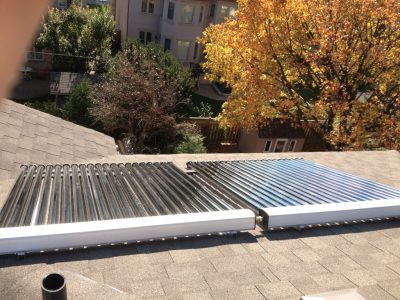 Building code requirements forced Hoyer to install an air-to-air heat exchanger as a back-up heat source, but it’s mostly just for show. The small amount of energy required for space heating beyond what’s produced internally by cooking, lighting and human bodies is usually supplied by a rooftop vacuum tube solar collector. It provides domestic hot water, too. The vacuum tube design greatly boosts heat-gathering action during cold weather. One sunny day when it was -10ºC outdoors, for instance, the vacuum tube system heated Hoyer’s 500 litre water storage tank all the way up to 60ºC. Space heating is delivered through a Rehau hydronic infloor system that also extends out onto the concrete front porch for melting ice and snow.
Building code requirements forced Hoyer to install an air-to-air heat exchanger as a back-up heat source, but it’s mostly just for show. The small amount of energy required for space heating beyond what’s produced internally by cooking, lighting and human bodies is usually supplied by a rooftop vacuum tube solar collector. It provides domestic hot water, too. The vacuum tube design greatly boosts heat-gathering action during cold weather. One sunny day when it was -10ºC outdoors, for instance, the vacuum tube system heated Hoyer’s 500 litre water storage tank all the way up to 60ºC. Space heating is delivered through a Rehau hydronic infloor system that also extends out onto the concrete front porch for melting ice and snow.
Fresh Indoor Air
Hoyer installed an HRV made by the European manufacturer Paul. The Novus 300 unit he chose extracts 99% of outgoing heat in stale air, compared to 70% to 80% for typical HRVs. Part of this amazing performance comes from the ground loop intake air supply. Air drawn into the HRV first travels through 90 feet of 8” diameter buried pipe. Even when it’s -15ºC outside, incoming air is a much friendlier 5ºC to 6ºC as it enters the HRV. In a sense, it’s like a mini ground source heat pump without any extra equipment. A humidity recovery coil in the HRV captures and recycles moisture from the outgoing air stream, eliminating the need for a humidifier. Hoyer’s currently working on plans to install a Geyser hot water heat pump to capture the heat lost by the HRV for supplemental heating on cloudy days. This heat pump will leverage the heat lost by the HRV, delivering an efficiency of about 300%.
At first glance, Hoyer’s project is impressive for practical reasons. Any Canadian house that stays warm furnace-free deserves front page coverage. But more important than this, Hoyer has advanced the definition of what’s practical and possible in the real world. Why would anyone settle for anything less?
Sidebar: Old Dog Snarls at New Tricks
Anyone who thinks building departments are useless needs to travel to a country where individuals are allowed to build entirely as they see fit. Without independent oversight, the building world turns into a disaster.That said, serious bottlenecks are appearing here in Canada because building code evaluation systems don’t always have the capacity to efficiently assess and approve the flood of innovative and worthy building products. Many current code approval systems were designed at a time in history when building innovations were few and far between, and these old processes remain.
“The biggest stumbling block I faced was getting efficient approvals from City Hall for a permit” says Hoyer. “This was a major fight that almost killed the project.”
The building work itself also posed challenges beyond the usual ones. “On the construction site, I had to constantly coach every trade carefully at each step of the way, since so much of this house involved unique and crucial processes”, explains Reiner. “No one could understand, for instance, why basement insulation was going up on walls and floors before framing, wiring and pipes went in. In the end, when they saw how the approach created a perfect shell of insulation and air tightness, they understood. You’ve got to choose your trades carefully. Their willingness to learn and work differently – without killing your budget – is key. From my experience, younger trades are more open minded and easier to teach than the guy who’s been God’s gift to the construction industry for the last 25 years.”
Does Hoyer consider all the trouble worth it?
“Absolutely. Living in a house that cost me less than $20 a month to heat in the middle of winter is a great thing. My wife’s breathing problems are a thing of the past now, too. Anyone can build this way at a budget very close to any ordinary custom home.”
